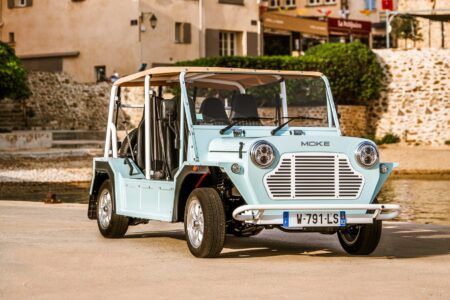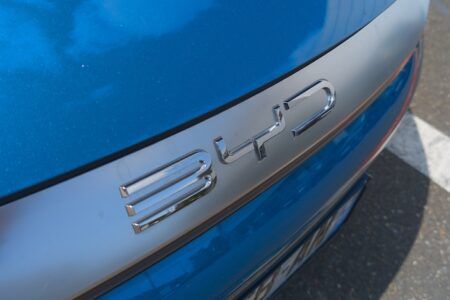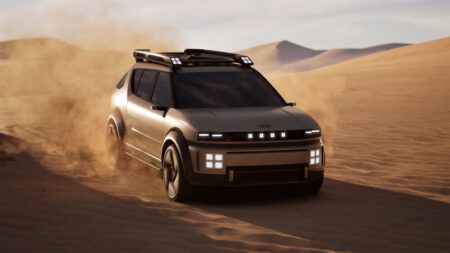The complex harnessing of solar energy to power electric vehicles is still relatively untapped, but new solutions are being introduced to make it a more affordable and mainstream technology. But are cars powered by the rays of the sun really the future of mobility?
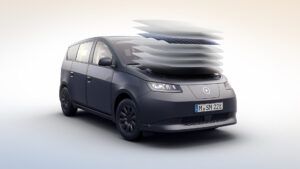 Right now, solar-power electric vehicle technology remains a minority innovation, mainly due to the involved nature of energy capture and power transfer. But there are many people out there who believe it won’t always be that way.
Right now, solar-power electric vehicle technology remains a minority innovation, mainly due to the involved nature of energy capture and power transfer. But there are many people out there who believe it won’t always be that way.
One of those people is Jan Schiermeister, VP technology at Sono Motors, although developing the technology for everyday use is not without its setbacks. Sono Motors had been developing the Sion, a solar-powered EV with monocrystalline silicon cells integrated into its body but had to terminate the program in early 2023. That initiative was intended for sale, so Sono Motors’ focus is now on business-to-business solar solutions, retrofitting and integrating its solar technology onto third party vehicles. A total of 25 customers – including Scania, Kögel and Chereau – are piloting its scalable solar technology on a variety of vehicle architectures.
“We have been working for years to realize polymer sandwich vehicle-integrated solar modules that can be made in almost every three-dimensional shape,” says Schiermeister. “The modules can be applied on vehicle sides, tailgate or hood, not only on the roof, fulfilling requirements for the PV and automotive sectors,” he says. “Although known photovoltaic (PV) modules aren’t designed for static use cases and especially not for automotive requirements, in regard to legal complexities such as crash behavior or flammability.”
Because of this, implementation of car body solar cells is a challenge, as strict occupant safety and pedestrian protection requirements have to be met. “Close cooperation with vehicle OEMs is required and retrofitting is more difficult,” says Georg Zurmühl, Sono Motors’ product manager. “However, our vehicle integrated photovoltaic (VIPV) technology based on automotive molding processes is unique, unlocking the potential for 3D-shaped solar body panels.” Zurmühl adds that the high volume manufacture, low cycle times and reasonable costs are key benefits.
“You can’t have solar without efficiency,” says Steve Fambro, co-founder and co-CEO of US solar EV start-up Aptera Motors. “The pursuit of efficiency first lets us do things such as solar mobility. But the technology has to be mobile as well as reliable, which adds an additional layer of application. If you took a solar panel and electronics IP we already have and put it on a regular car, it won’t have any appreciable impact.” Which is why Fambro believes a ground-up approach is the best solution to leverage the technology.
He explains that the sky-facing surfaces on the body of Aptera’s first solar EV are clothed in solar polymer sandwich panels that use a proprietary technology, which encapsulates the solar cell itself to protect it against moisture and oxygen. Aptera has patents for the use of glass or plastic for the front and rear panel surfaces, and either material can be used depending on the application. “It also has to be lightweight and has to produce power when spread across the vehicle when part of it is shaded or covered,” says Fambro. “Developing curved solar panels for vehicles that are lightweight enough to manufacture while able to withstand hail strikes, vibration and thermal cycling, has been the main focus of our IP.”
Up to 700 watts of continuous charging power is released by Aptera’s solar panels, enough for up to 40 miles of range per day. Over the course of a year, Fambro believes a location such as San Diego has the potential to capture as much as 11,000 miles’ worth of solar energy – 4kWh per day. Batteries of 25, 40, 60 or 100kWh are mooted, using Lithium Nickel-Cobalt-Aluminum Oxide (NCA) chemistry, and EVE Energy Co’s 21700 NMC 811 cylindrical cells. The Launch Edition car will have the 40kWh battery – actually 42kWh usable, 45kWh gross capacity – with up to 400 miles of range and a projected efficiency target of up to 10mpkWh (100Wh/mile). Liquid-cooling enables reliable 40-60kW NACS fast charging.
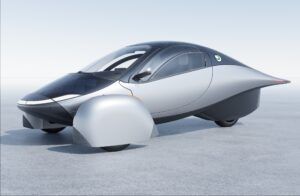 Rays of hope
Rays of hope
With a history in development of solar-powered EVs, a team from the Eindhoven University of Technology has recently completed extensive testing in Morocco of the road legal Stella Terra, a solar-powered off-road EV with the potential to travel 390 miles on a sunny day. Niels van den Broek, a Solar Team Eindhoven electrical engineer, says regular solar panels could not be used, as they would compromise aerodynamics and add unnecessary weight. “We opted for flexible panels – consisting of a commonly used plastic back and front sheet, housing the solar cells with adhesive in-between – that could be placed on our single-curved bonnet and roof,” he says. “The solar cells are relatively standard, with a high efficiency of 23.7%. Employed in domestic solar panels, our project shows even with ‘normal’ solar cells, it is feasible to make a car fully powered by the sun.”
While specialist technology is not always essential, a more proprietary approach is better able to employ solar energy in increasingly concentrated ways. Schiermeister explains Sono’s unique microcontroller or electronic control unit (MCU) has both a high efficiency and high-voltage capabilities, enabling a highly efficient solar yield while driving. “Our power electronics is a specially designed multi-channel concept, combining several maximum power point trackers (MPPTs) in one box. This allows for both efficient and independent operation of several solar modules with different orientations towards the sun. It adapts super quickly to fast-changing sun radiation conditions, key for mobile solar applications where every harvested Wh is valuable,” Schiermeister elaborates.
Van den Broek explains Solar Team Eindhoven’s biggest challenge was the absence of a 400V MPPT. “Without an MPPT, solar panels on a car will be less effective or even useless. In Stella Terra, the battery voltage varies between 280 to 400V, depending on the state of charge (SoC). However, the voltage output of our solar groups varies between 50-90V. This implies a power converter should be placed between the solar groups and our HV system; otherwise, the current generated by the solar panels will not flow into the battery. Think of it like water; water only flows from a higher point to a lower point – current only flows from higher current to lower current,” he says.
Another obstacle in making a solar-powered vehicle is the relative contribution of solar power to the total power used by the vehicle itself. “Placing a few solar panels on a vehicle may only produce enough energy for a small percentage of the total energy usage,” says Van den Broek. “Our goal was to create a solar-powered vehicle that could drive solely on solar energy. This required significant effort to design a lightweight and aerodynamic car that consumes as little energy as possible.”
A lightweight structure not only benefits efficiency, but also the solar energy technology itself. Aptera uses a form of carbon composite with a very high rate of production. Inspired by aircraft with a low frontal area and small cross-section, the car has a teardrop shape and an aluminum belly pan. Two front wheels and one rear wheel aid the projected efficiency. “There’s one less wheel so there’s a significant amount of structure that’s not needed to support a fourth quarter,” Fambro explains. A low drag coefficient of 0.13 means the Aptera’s body is as optimized as it can be, too.
Further efficiencies can be made through the use of direct-drive powertrains. “Looking at how efficiency stacks up, in-wheel motors are the next step,” says Fambro. Aptera has been working with direct drive powertrain specialist Elaphe to co-design its current motor, which is a derivative of what the company produces. “However, it has been redesigned to be the absolute most efficient in our power regime, for torque, rpm and typical loading,” says Fambro. With an eye on even further efficiencies, silicon carbide inverter technology is also being evaluated.
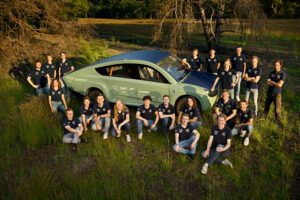 Here comes the sun
Here comes the sun
In-wheel motors from Protean were chosen for the Stella Terra. “In-hub motors eliminate the need for drive shafts, enhancing aerodynamics,” says says Van den Broek. “Protean motors also have up to 93% efficiency, encompassing motor and inverter, and have the highest IP-rating possible. They also adhere to the ISO26262 functional safety standard, instilling confidence in their reliability. Housing the motor and inverter in one unit significantly eased incorporation of the motors into the Stella Terra’s electrical architecture.” A 16-strong team began development of the Stella Terra in September 2022. A year later, with an expanded team of 22, the off-road car was presented in its final form. Tests on the energy usage of different off-road surfaces provided valuable insights, ensuring the EV could complete its challenging 620-mile (1,000km) tour solely on solar power.
Due to their high energy demand used for consumers such as infotainment screens, HVAC systems, and repeated door opening and closing functions, buses and delivery service vehicles currently appear to benefit the most from solar technology. “Diesel buses burn fuel for those functions and benefit greatly if this fuel is replaced by solar power,” says Zurmühl. “E-buses and cooled goods delivery vehicles lose driving range as the battery has to power the consumers, and this is why solar integration is so beneficial.” Solar also benefits hybrid vehicle applications, but the gains are less marked and depend on individual usage cases.
To see solar-powered EV technology become more widespread, Fambro believes that a mass adoption by industry would be needed, accompanied by more efficient platforms. “That comes back to the ground-up approach, which really has to be a ground-up rethink of what efficient transportation looks like,” he says, believing other low speed mobility markets away from the passenger car sector have more readily available opportunities.
Van den Broek thinks that every EV sector can benefit from solar technology, but that solar integration does come at a cost, and a return on investment is expected. “Additionally, there are geographical variations, with some locations having greater solar power production potential than others,” he says. It is for this reason Van den Broek views solar integration primarily, for now, as a supplemental option.
Yet Schiermeister feels all sectors where there is sufficient consumption of energy and the cost of energy and range plays a role will benefit. “Short term, commercial vehicles such as buses and refrigerated vehicles will benefit as they have an additional high energy demand over the high energy demand for driving,” he says. “As they have huge surfaces that can be covered with solar panels, the implementation is relatively easy.” While believes that in the mid-term, integration into passenger car body panels will benefit this sector, unlocking huge potential for higher solar energy yields per vehicle, Schiermeister concedes that solar may always be an add-on. “It will enrich traditional EVs and not challenge them. OEMs may offer optional solar solutions, but with increasing efficiencies and sinking costs of solar cells and because energy from the sun is free – after the initial investment, solar integration has the potential to become a broad EV application.”
Fambro says first Aptera deliveries are projected to arrive nine to 12 months after the closure of the company’s major funding round which currently remains open, but how far into the future will solar technology start to challenge more traditional EV applications? “We strive to stay 5-10 years ahead of the market, demanding specialist technology for our solar integration,” says Van den Broek. “Our vision is that within 10 years, most car companies will offer an option to integrate solar panels on certain models, with an increasing number of vehicles actively using solar panels to charge their batteries.”



